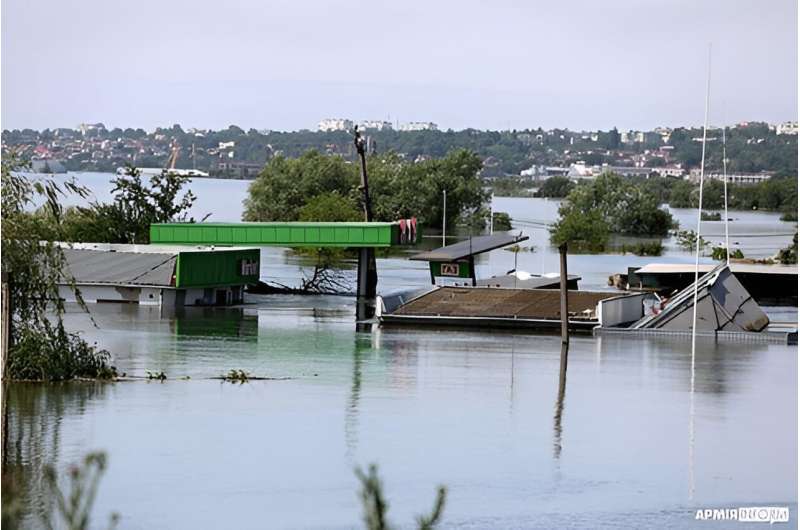This article has been reviewed according to Science X's editorial process and policies. Editors have highlighted the following attributes while ensuring the content's credibility:
fact-checked
peer-reviewed publication
trusted source
proofread
Rapid study of Kakhovka Dam breach impacts will support biodiversity's recovery

UK scientists' unprecedented rapid assessment of the environmental impacts of the Kakhovka Dam's breach will support international action to restore a biodiversity hotspot.
With the area in southern Ukraine in a warzone, the UK Centre for Ecology & Hydrology (UKCEH) and HR Wallingford has used cutting-edge technologies to carry out the first independent assessment of the impacts within weeks of the dam being breached in June.
It estimated that half a million hectares of protected freshwater and terrestrial habitats have been exposed to a range of hazards, including nutrients, pollutants from 1,000 sites and the erosion of sediment. This follows widespread flooding downstream and the near-emptying of the upstream Kakhovka Reservoir.
The research is available on the Zenodo website, and a commentary by first author Professor Bryan M. Spears has been published in the journal Nature Ecology & Evolution.
Environmental assessments have previously taken place only after a war, when it is safe for scientists to carry out in-depth field studies, but this has limited the scope of targeted biodiversity restoration within post-conflict recovery planning.
The Kakhovka study combined hydrological and digital modeling with satellite imagery and a study of data on the region's ecology. This enabled the identification of protected habitats and species likely to be impacted by the breach, setting a precedent for early action in future conflicts.
The report's key findings were:
- Around 83,000 hectares of land, an area the size of Kyiv, was flooded downstream of the dam. The discharge of water was 30,000 m3 per second immediately after the breach, compared to a daily average of 2,600 m3/sec
- The Kakhovka Reservoir was almost completely emptied, leaving thousands of fish washed out or stranded. This included an estimated 28,000 crucian carp, totaling 95,000 tons with an estimated commercial value of US $108 million
- There were more than 1,000 potential sources of pollution from flooded sites, including wastewater treatment works, petrol stations, landfills and industrial sites
- The erosion of sediment following the flood might also have released historic pollutants, such as metals, stored in sediments
- The breach affected over half a million hectares of habitats of national or international importance, upstream and downstream of the dam, including the Black Sea Biosphere Reserve
- Some 28 of the 567 species affected by a range of hazards are globally threatened or worse, including the Great Bustard, Pontic Shad, Harbor porpoise, Donets ruffe, the Steppe Polecat, the European mink and the slender-billed curlew, the latter being on the verge of extinction.
Professor Spears, of UKCEH, says, "We hope that our assessment provides a baseline against which to assess biodiversity and habitat impacts and recovery related to the Kakhovka Dam breach. It is now important that the results of this and other assessments are scrutinized fully by the wider scientific community, allowing biodiversity restoration to be incorporated within post-conflict recovery planning at an early stage."
Emma Brown, technical director at HR Wallingford, adds, "I am very proud of the work we've done with UKCEH to assess the environmental impacts of the Kakhovka Dam breach. Combining our expertise in dam breach modeling, hydrology and earth observation with UKCEH's expert biodiversity knowledge enabled the team to produce a detailed report in just 16 days, which I hope will be instrumental in helping with recovery efforts in the region."
The report, which informed a wider report by the UN Environment Program, also identified potential long-term effects on the environment, human health and economies. It said the flooding would have worsened water infrastructure and quality, affecting drinking water supply and irrigation for agriculture. The authors made several recommendations for future action.
Professor Harry Dixon, Associate Director of International Research and Development, UKCEH, comments, "This significant work undertaken in a timely way using cutting-edge technologies highlights the importance of using science from organizations to inform humanitarian and environmental response to disasters and emergencies across the globe."
More information: Study: Bryan Spears et al, A rapid assessment of the immediate environmental impacts of the destruction of the Nova Kakhovka Dam, Ukraine, Zenodo (2023). DOI: 10.5281/zenodo.10462809
Commentary: Bryan M. Spears et al, A rapid environmental risk assessment of the Kakhovka Dam breach during the Ukraine conflict, Nature Ecology & Evolution (2024). DOI: 10.1038/s41559-024-02373-0
Journal information: Nature Ecology & Evolution
Provided by UK Centre for Ecology & Hydrology

















